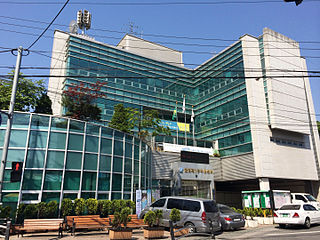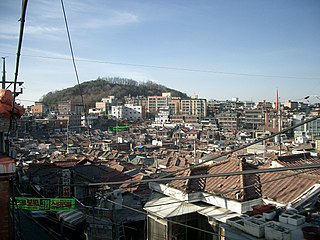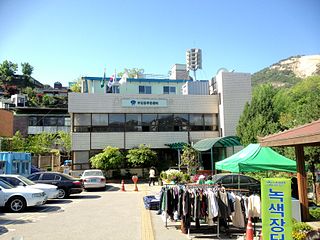Related Research Articles

Bongcheon Station is a station on the Seoul Subway Line 2. It is located in Bongcheon-dong, Gwanak District, Seoul, South Korea, close to Gwanaksan Mountain.

Seoul National University Station is a station on Seoul Subway Line 2, located in Bongcheon-dong, Gwanak-gu of southern Seoul. This station is also known as Gwanak-gu Office Station. There are eight exits, two at each corner of the crossroads – of Nambu Beltway (Nambusunhwan-ro) and Gwanak-ro – where the station lies beneath.

Bangbae-dong (Korean: 방배동) is a dong (neighborhood) of the greater Gangnam area Seocho District of the South Korean city of Seoul. Bangbae-dong is divided into 5 different dongs which are Bangbaebon-dong, Bangbae 1-dong, 2-dong, 3-dong and 4-dong. The origin of Bangbae-dong is derived from the name Bangbae, meaning "dong-ri with my back to Mt. Myeon-ri," which rises on the border between Gwanak District and Seocho District. Bangbae-dong was Bangbae-ri, Sangbuk-myeon, Gwacheon-gun, Gyeonggi-do until the end of the Joseon Dynasty, but became Bangbae-ri, Sindong-myeon, Siheung-gun, Gyeonggi-do in 1914 when the area was confirmed during the Japanese colonial period. It was incorporated into the Seoul Metropolitan Government following the expansion of the Seoul Metropolitan Government's zone in 1963, and became Bangbae-dong to this day. The location is Dong at the western end of Seocho District, and it is an area from the intersection of the road from Seoul to Gwacheon and the southern circulation road to Umyeon Mountain.

Bulgwang-dong (Korean: 불광동) is a neighborhood (dong) of Eunpyeong District, Seoul, South Korea.

Galhyeon-dong (Korean: 갈현동) is a dong (neighborhood) of Eunpyeong District, Seoul, South Korea. It is divided into two sub-districts, Galhyeon 1-dong and Galhyeon 2-dong. The northern boundary is Jingwan-dong, while Bulgwang-dong lies to the east. To the south, it shares borders with Gusan-dong and Daejo-dong, and to the west lies Changneung-dong in Goyang-si, Gyeonggi-do. As of May 2017, Galhyeon-dong spans an area of 1.93km2 and has a registered resident population of 56,047, with 25,550 residing in Galhyeon 1-dong and 30,497 in Galhyeon 2-dong.

Banghwa-dong (Korean: 방화동) is a dong (neighborhood) of Gangseo District, Seoul in Seoul, South Korea.

Doksan-dong (Korean: 독산동) is a dong (neighborhood) of Geumcheon District, Seoul, South Korea.

Bongcheon-dong (Korean: 봉천동) is a statutory division of Gwanak District, Seoul, South Korea. Its name means "enshrining heaven" which was derived from its location, northern skirt of Mt. Gwanak, stretching to the mountain ridge. It consists 9 administrative neighborhoods. District office of Gwanak is located in Bongcheon.

Sillim-dong (Korean: 신림동) is a dong (neighborhood) of Gwanak District, Seoul, South Korea. Seoul National University and Nokdu Street are located in the town. Its name means "new forest", which was derived from the woods outstretched from Mt. Gwanak. It consists 11 administrative neighbourhoods.

Sogong-dong (Korean: 소공동) is a dong (neighborhood) of Jung District, Seoul, South Korea.
Cheongun-dong is a dong (neighborhood) of Jongno District, Seoul, South Korea.
Changseong-dong is a dong (neighborhood) of Jongno District, Seoul, South Korea. It is a legal dong administered under its administrative dong, Hyoja-dong.

Buam-dong is a dong (neighborhood) of Jongno District, Seoul, South Korea.
Chebu-dong is a dong (neighborhood) of Jongno District, Seoul, South Korea. It is a legal dong administered under its administrative dong, Sajik-dong.

Hongji-dong is a dong (neighborhood) of Jongno District, Seoul, South Korea. It is a legal dong administered under its administrative dong, Buam-dong.

Anguk-dong is a dong, neighbourhood of Jongno District, Seoul, South Korea. It is a legal dong administered under its administrative dong, Samcheong-dong.
Pyeong-dong (Korean: 평동 is a dong of Jongno District, Seoul, South Korea. It is a legal dong administered under its administrative dong, Gyonam-dong.

Bukgajwa-dong (Korean: 북가좌동) is a dong (neighborhood) of Seodaemun District, Seoul, South Korea. Seoul Metropolitan City Tangible Cultural Heritage Number 41, Hwasangunsindobi, is located here.

Bugahyeon-dong (Korean: 북아현동) is a dong (neighborhood) of Seodaemun District, Seoul, South Korea.
Bongwon-dong (Korean: 봉원동) is a legal dong (neighborhood) of Seodaemun District, Seoul, South Korea and is governed by its administrative dong, Sinchon-dong's office. Bongwon-dong has the Bongwon-Temple(Bongwonsa) built by Great master Doseon (827–898) in 889, 3rd year of Jinseong Queen, the 51st of the Silla Dynasty. Bongwon-Temple gives opportunities for visitors to experience "Seoul Lotus Festival" and "Yeongsamjae ritual" annually.
References
- 1 2 남현동 (Namhyeon-dong 南峴洞) (in Korean). Doosan Encyclopedia . Retrieved 2008-04-19.[ permanent dead link ]
- ↑ "The origin of Namhyeon-dong" (in Korean). Gwanak District official site. Retrieved 2008-04-20.
